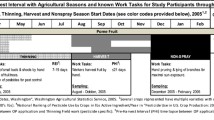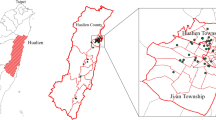Abstract
Residues for 17 pesticides were analyzed in 41 households in central New York State that represented farm, rural, and urban houses. Samples were taken in both summer and winter of 2000–2001 from the same households from four locations; family room carpet; adjacent smooth floor; flat tabletop surface; and settled dust collected in a Petri dish on a tabletop. Pesticide residues were analyzed to identity factors that influence both the transport into and the redistribution of pesticides in the indoor environment. Differences were observed between the various pesticides and pesticide classifications relative to location within and between households as well as by season. Variations in the pesticide residues were related to a number of factors. Higher residues were observed in the farm households, particularly in summer, with the highest amount observed for chloropyrifos in carpet (33 μg/m2). For many pesticides, the frequency of detection and the amount of residues were higher in summer, which relates to usage patterns in agriculture and horticulture; however, larger amounts of insecticides such as mecoprop, resmethrin, and tetramethrin were found on flat surfaces in winter, indicating household use and possible redistribution within the home. Distribution patterns suggest that routines within a household may cause high variation in residues; these practices include indoor pets and treatment for fleas and ticks, use of termiticides, and fastidiousness of occupants. Frequency of pesticide detection was highest in carpet for both summer and winter for all households, indicating that carpets hold pesticides over time. Adsorbent fibrous materials such as textiles hold pesticides by macro- and micro-occlusion in their complex structures. Amounts of pesticide residue were higher in carpets than on smooth floors, particularly for rural farm households where the farmer was a certified pesticide applicator. The maximum amount of pesticide residue on a smooth floor surface was 13.6 μg/m2 malathion while the maxima on wiped surfaces and in settled dust were 1.8 μg/m2 2, 4 D and 3 μg/m2 pendimethalin, respectively. Physical properties of individual pesticides such as vapor pressure influenced the distribution of the pesticide within the households. Evidence of volatilization of pesticides and redeposition on surfaces was observed, indicating that this is a mechanism for contamination of surfaces in addition to adsorption on airborne particles and tracking. High residues in winter are evidence that closure of households in winter that reduces ventilation results in redistribution of pesticides within households.





Similar content being viewed by others
References
Berkowitz GS, Obel J, Deych E, Lapinski R, Godbold J, Liu ZS, Landrigan PJ, Wolff MS (2003) Exposure to indoor pesticides during pregnancy in a multiethnic, urban cohort. Environ Health Perspect 111(1):79–84
Butte W, Heinzow B (2002) Pollutants in house dust as indicators of indoor contamination. Rev Environ Contam Toxicol 175:1–46
Calabrese EJ, Stanelc EJ III (1992) What proportion of household dust is derived from outdoor soil? J Soil Contain 1:253–263
Clayton AC, Pellizzari ED, Whitmore RW, Quackenboss JJ, Adgate J, Sefton K (2003) Distributions, associations, and partial aggregate exposure of pesticides and polynuclear aromatic hydrocarbons in the Minnesota Children’s Pesticide Exposure Study (MNCPES). J Expo Anal Env Epid 13(2):100-111
Colt JS, Lubin J, Camann D, Davis S, Cerhan J, Severson RK, Cozen W, Hartge P (2004) Comparison of pesticide levels in carpet dust and self-reported pest treatment practices in four US sites. J Expo Anal Env Epid 14:74–83
Colt JS, Zahm SH, Camann DE, Hartge P (1998) Comparison of pesticide and other compounds in carpet dust samples collected from used vacuum cleaner bags and from a high-volume surface sampler. Environ Health Perspect 106:721–724
Curl CL, Fenske RA, Kissel JC, Shirai JH, Moate TF, Griffith W, Coronado G. Thompson B (2002) Evaluation of take-home organophosphorus pesticide exposure among agricultural workers and their children. Environ Health Perspect 110(12):A787–92
EPA (2000) Memorandum of agreement between the environmental protection agency and signatory registrants regarding the registration of pesticide products containing chlorypyrifos. http://www.epa.gov/pesticides/op/chlorpyrifos.htm (viewed April 2005)
Eskenazi B, Harley 1C, Bradman A, Weltzien E, Jewell NA, Barr DB, Furlong CE, Holland NT (2004) Association of in utero organophosphate pesticide exposure and fetal growth and length of gestation in an agricultural population. Environ Health Perspect 112(10):1116–1124
Fenske R, Curry P, Wandehnaier F, Ritter L (1991) Development of dermal and respiratory sampling procedures for human exposure to pesticides in indoor environments. J Expos Anal Environ Epi 1:11–30
Fenske RA, Kissel JC, Lu C, Kalman DA, Simcox NJ, Alien EH, Keifer MC (2000) Biologically based pesticide dose estimates for children in an agricultural community. Environ Health Perspect 108:515–520
Gurunathan S, Robson M, Freeman N, Buckley B, Roy A, Meyer R (1998) Accumulation of chlorpyrifos on residential surfaces and toys accessible to children. Environ Health Perspect 106:9–16
Hedge A, Kline AA, Lemley AT, Obendorf SK, Dokuchayeva T, Gaskins V (2002) Contaminants in residential floor dust, Proc. Indoor Air 2002, Monterey, CA, 1:998–1003
Hong S, Kim J, Lemley AT, Obendorf SK, Hedge A (2001) Analytical method development for 18 pesticides in house dust and settled residues using SEC, SPE, TMS Methylation, and GC-MS. J Chromatogr Sci 39(3):101–112
Kamel F, Hoppin JA (2004) Association of pesticide exposure with neurologic dysfunction and disease. Environ Health Perspect 112(9):950–8
Kidd H, James DR (eds) (1991) The agrochemicals handbook, 3rd ed. Royal Society of Chemistry Information Services, Cambridge, UK, 10–12
Lemley A, Hedge A, Obendorf SK, Hong S, Kim J, Muss TM, Varner CJ (2002) Selected pesticide residues in house dust from farmers’ homes in central New York State. Bull Environ Contain Toxicol 69:155–163
Lewis RG, Fortmann RC, Camann DE (1994) Evaluation of methods for monitoring the potential exposure of small children to pesticides in the residential environment. Arch Environ Contain Toxicol 26:1–10
Lewis RG, Fortune CR, Willis RD, Camann DE, Antley JT (1999) Distribution of pesticides and polycyclic aromatic hydrocarbons in house dust as a function of particle size. Environ Health Persp 107(9):721–726
Lu CS, Fenske RA, Simcox NJ, Kalman D (2000) Pesticide exposure of children in an agricultural community: Evidence of household proximity to farmland and take home exposure pathways. Environ Res 84(3):290–302
Ott WR, Roberts JW (1998) Everyday exposure to toxic pollutants. Sci Am 278:86–91
Tinoco-Ojanguren R, Halperin DC (1998) Poverty, production and health: Inhibition of erythrocyte cholinesterase via occupational exposure to organophosphate insecticides in Chiapas, Mexico. Arch Environ Health 53:29–35
Tomlin CDS (1997) The pesticide manual, 11th ed. British Crop Protection Council, Surrey, UK
Whitmore RW, Immerman FW, Camann DE, Bond AE, Lewis RG, Schaum JL (1994) Non-occupational exposures to pesticides for residents of two U.S. cities. Arch Environ Contam Toxicol 26:47–59
Whyatt RM, Camann DE, Kinney PL, Reyes A, Ramirez J, Dietrich J, Diaz D, Holmes D, Perera FP (2002) Residential pesticide use during pregnancy among a cohort of urban minority women. Environ Health Perspect 110(5):507–514
Williams R, Bernard CE, Krieger RI (2003) Human exposure to indoor residential cyfluthrin residues during a structured activity program. J Exposure Anal Environ Epidemiol 13:112–119
Acknowledgments
This research was supported in part by the Cornell University Agricultural Experiment Station federal formula funds, Projects No, NYC327402, 329423, and 329478 received from Cooperative State Research, Education, and Extension Service, U.S. Department of Agriculture, and by a grant from the Carpet and Rug Institute. We thank A. Achecar, M. Ames, C. Coffman, V. Gaskins, D. Heath, and T. Miller for their assistance with this work. Particular appreciation is given to Françpoise Vermeylen for advice and assistance on the statistical analyses.
Author information
Authors and Affiliations
Corresponding author
Rights and permissions
About this article
Cite this article
Obendorf, S., Lemley, A., Hedge, A. et al. Distribution of Pesticide Residues Within Homes in Central New York State. Arch Environ Contam Toxicol 50, 31–44 (2006). https://doi.org/10.1007/s00244-004-0185-y
Received:
Accepted:
Published:
Issue Date:
DOI: https://doi.org/10.1007/s00244-004-0185-y




